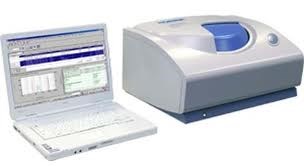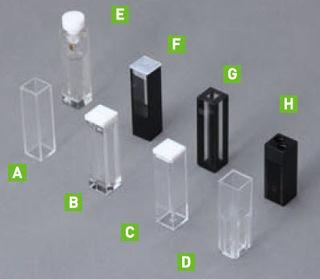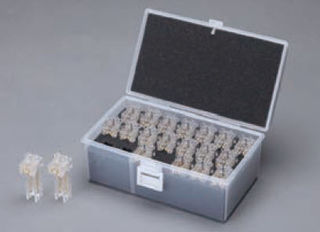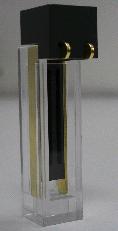
SZ Particle Size Analyser
Product Category: Particle Size Analysis
Industry: Life Sciences, Particle and surface science
Supplier: Horiba
Description
The SZ-100 nanopartica series instruments are flexible analytical tools for characterizing the physical properties of small particles. Depending on the configuration and application the system can be used as a particle size analyzer, or also used to measure zeta potential, molecular weight, (MW) and second virial coefficient (A2). Typical applications for the SZ-100 include nanoparticles, colloids, emulsions, and submicron suspensions.
Particle size analysis is performed by dynamic light scattering (DLS). Depending on the physical properties of the sample, the dynamic range is 0.3 nm – 8 µm. The lower limit is influenced by concentration, how strongly the sample scatters light, and the presence of large, unwanted particles. The upper limit is influenced by the density of the sample since DLS is modeled on all motion coming from Brownian motion, not gravitational settling.
The charge on the surface of particles is characterized by the SZ-100 by measuring the zeta potential of a suspension. The sample is injected into a disposable cell and a measurement of the particle electrophoretic mobility results in the calculated zeta potential. The zeta potential of the sample is most often used as an indicator of dispersion stability. Large magnitude zeta potential values indicate that an electrostatically stabilized suspension will remain stable. The zeta potential is often measured as a function of pH or other change in the chemistry to help formulators create new products with a long shelf life. Conversely identifying conditions at which the zeta potential is zero (that is, the sample is at the isoelectric point) allows one to choose optimum conditions for flocculating and separating particles.
The same instrument can also be used to measure the molecular weight and second virial coefficient of proteins, polymers, and other molecules. The user prepares several solutions with known concentrations and then uses the system in a static light scattering mode to create a Debye plot, which results in a calculation of both MW and A2.
Particle Size Measurement Range 0.3 nm to 10 µm
The SZ-100V2 Series measures particle size and particle distribution width by dynamic light scattering (DLS).
Analysis across a wide range of sample concentrations: Measurement of samples ranging from low ppm-order concentrations to high-concentration samples in double-digit percentages is possible. Accepts commercially available sampling cells. Analysis of small-volume samples is also possible.
Zeta Potential Measurement – 500 to + 500 mV
Analysis of sample volumes as small as 100 μL using HORIBA-developed microelectrophoresis cells. Use the value of zeta potential to predict and control dispersion stability. High zeta potential magnitudes indicate a stable dispersion, useful for formulation work.
Molecular weight 1 × 103 to 2 × 107 Da
Absolute molecular weight (Mw) and the second virial coefficient (A2) are obtained by performing static light scattering measurement as a function of sample concentration and preparing Debye plots.
The SZ-100V2 Series applies sophisticated intelligence and learning capability to rapidly determine nanoparticle properties!
- Since the SZ-100V2 Series analyzer covers a wide sample concentration measurement range, sample dilution and other preprocessing is nearly eliminated.
- The use of a dual optical system enables measurement of high-concentration samples such as slurry and ink pigments as well as low-concentration proteins and polymers.
- A single device analyzes the three parameters that characterize nanoparticles: particle size, zeta potential, and molecular weight.
- HORIBA-developed cells for zeta potential measurement prevent sample contamination. Simple analysis by means of ultra micro-volume dedicated cells (volume as low as 100 μL). Suitable for analysis of dilute samples.
- HORIBA-developed electrode for zeta potential cell made from carbon material, the material is not corroded by high salt samples such as saline.
Specifications
SZ-100-S2 Measurement Specifications
| Model | SZ-100-S2 (particle size and molecular weight measurement only) |
|---|---|
| Measurement principles | Particle size measurement: Dynamic Light Scattering Molecular weight measurement: Debye plot method (static scattered light intensity) |
| Measurement range | Particle size: 0.3 nm to 10 μm Molecular weight: 1000 to 2 x 107 Da (Debye plot) 540 to 2 x 107 Da (MHS Equation)*1 |
| Maximum sample concentration | 40 wt%*2 |
| Particle size measurement accuracy | Measurement accuracy of ±2% for NIST traceable polystyrene latex 100 nm spheres (not including variation in the standard particles themselves) |
| Measurement angles | 90° and 173° (automatic or manual selection) |
| Cells | Cuvettes |
| Measurement time | Approx. 2 min. under ordinary conditions (from the start of measurement to the display of results for particle size measurement) |
| Required sample volume | Minimum volume of 12 μL*3 to 1000 μL (differs depending on cell material) |
| Usable liquids | Water, ethanol, organic solvents |
*1: Mark-Howink-Sakurada Equation, depending on sample.
*2: Depending on sample.
*3: F Micro-cell.
SZ-100-Z2 Measurement Specifications
(Particle size and molecular weight measurement specifications are the same as for the SZ-100-S2.)
| Model | SZ-100-Z2 (with zeta potential measurement unit) |
|---|---|
| Measurement principle | Zeta potential measurement: Laser Doppler electrophoresis |
| Measurement range | -500 to +500 mV |
| Size range suitable for measurement | Minimum 2.0 nm, Maximum 100 μm*4 |
| Measurement conductivity range | 0 to 20 S/m*5 |
| Maximum sample concentration | 40 wt%*6 |
| Cells | Dedicated cell with electrodes |
| Measurement time | Approx. 2 min. under ordinary conditions |
| Required sample volume | 100 μL |
| Carrier fluids | Water |
*4: Depending on sample.
*5: Recommended sample conductivity range: 0 to 2 S/m.
*6: Depending on sample.
Analyzer Specifications (SZ-100-S2 and SZ-100-Z2)
| Measuring unit optical system | Light source: Diode pumped frequency doubled laser (532 nm, S2 / Z2 10 mW, HS2 / HZ2 100 mW) Detectors: Photomultiplier tubes (PMT) |
|---|---|
| Laser classification | Class I |
| Operating temperature and humidity | 15 - 35 °C, RH 85% or less (no condensing) |
| Holder temperature control temperature settings | 0 - 90 °C (up to 70 °C for cells with electrodes and plastic cells) |
| Purging | Dry gas purge port tube connection is possible. |
| Power supply | AC 100 - 240 V, 50/60 Hz, 150 VA |
| Dimensions | 528 (W) x 385 (D) x 273 (H) mm (excluding protrusions) |
| Weight | 25 kg |
| Personal computer | Windows computer with one available USB port |
| Interface | USB 2.0 (between measuring unit and PC) |
| OS | Windows® 10 32/64 bit |
Dimensions (mm)

Accessories
Particle size cells

| Cell name | Min volume | Solvent | |
|---|---|---|---|
| A | Disposable cell | 1.2 mL | Aqueous |
| B | Semi-micro cell | 500 µL | Aqueous, non-aqueous |
| C | Glass cell | 1.2 mL | Aqueous, non-aqueous |
| D | Semi-micro disposable cell | 600 µL | Aqueous |
| E | Cell with lid | 1.2 mL | Aqueous, non-aqueous |
| F | Micro cell (90° only) | 12 µL | Aqueous, non-aqueous |
| G | Sub-micro cell | 200 µL | Aqueous, non-aqueous |
| H | Flow cell | 100 µL | Aqueous, non-aqueous |
Zeta potential cells

Disposable zeta potential cells for aqueous measurements. Box of 20 Volume = 100 µL

Non-aquoeus zeta potential cell. Volume = 100 µL

